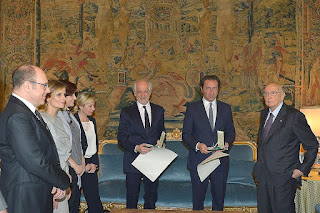Naples-born star of The Hand of God
 |
| Luisa Ranieri in a scene from The Hand of God, which won her a Best Supporting Actress award |
Ranieri, who is married to Inspector Montalbano actor Luca Zingaretti, was honoured with a prestigious Nastro d’Argento for her portrayal of Patrizia, the troubled aunt of The Hand of God’s central character, Fabietto.
Among more than 30 films in a big screen career that began with a leading role in Leonardo Pieraccioni’s Il principe e il pirata (The Prince and the Pirate) in 2001, Ranieri is also well known for her performances in Michelangelo’s Antonioni’s Eros in 2004, in Pupi Avati’s Gli amici del Bar Margherita (The Friends of the Bar Margherita) in 2009 and Gary Winick’s final film, Letters to Juliet (2010).
Ranieri, whose latest movie, Diamanti, (Diamonds) directed by Ferzan Özpetek, premieres in Italy this week, also boasts a string of successes in television.
In 2005, she won plaudits for her portrayal of the opera singer Maria Callas in a Canale 5 miniseries Callas e Onassis, and for playing the entrepreneur Luisa Spagnoli in the Rai fiction of the same name in 2016. Since 2021 she has filled the title role in the Rai crime series, Le indagini di Lolita Lobosco, (The Investigations of Lolita Lobosco) in which she plays a deputy commissioner of police in the southern Italian city of Bari.
 |
| Ranieri won acclaim for her portrayal of Maria Callas |
Ranieri spent her early years in the Vomero district of Naples, an upmarket suburb which occupies an elevated position that offers commanding views over the city. She enrolled in the Faculty of Law in the city’s university but gave up her studies to devote herself to acting, building the foundations of a career as a theatre actress before quickly landing the part in Il principe e il pirata in 2001, in which she also gained considerable exposure thanks to a starring role on a TV advertising campaign for Nestea, a major player in Italy’s lucrative iced tea market.
She quickly established her reputation as an actress of considerable talent, gaining significant recognition through TV roles, including playing Assunta Goretti, the mother of the child saint, Maria Goretti, who was murdered at the age of 11, in Giulio Base’s 2003 miniseries, and two years later Maria Callas opposite the Aristotle Onassis of French actor Gérard Darmon under Giorgio Capitani’s direction.
In 2009, the same year that Avati’s Gli amici del bar Margherita brought more critical acclaim, she demonstrated her versatility with a return to the stage, acting in the theatrical production of L'oro di Napoli (the Gold of Naples), directed by Gianfelice Imparato and Armando Pugliese, based on the stories of Neapolitan life by Giuseppe Marotta.
 |
| The terrace at the Castello di Donnafugata will be familiar to fans of the Montalbano TV series |
As a further recognition of her standing in the acting profession, Ranieri was chosen to host the opening and closing nights of the 71st Venice International Film Festival in 2014.
Her marriage to Zingaretti caught the public imagination. After living together for several years, the couple tied the knot at the Castello di Donnafugata, a castle near Ragusa in Sicily where scenes were filmed in several episodes of the long-running Inspector Montalbano series.
.jpg) |
| The Castel Sant'Elmo and the Certosa di San Martino tower above Naples on Vomero hill |
The Vomero district of Naples is widely-regarded as the most upmarket area of the city in which to live. Perched on a hill overlooking the city and the Bay of Naples, it is known for its elegant architecture, beautiful parks, and a more relaxed atmosphere compared to the sometimes chaotic nature of the southern Italian city’s centre. Highlights include Castel Sant'Elmo, a mediaeval fortress offering stunning panoramic views of the city and the bay; the adjoining Certosa di San Martino, a former monastery that now houses a museum; the lively Piazza Vanvitelli, Vomero’s central square; and the Villa Floridiana, a beautiful park with gardens, fountains and another museum. Three funicular railways connect Vomero to the city centre. The district boasts a mix of high-end and local shops and a similar variety of restaurants.
 |
| The magnificent Duomo di San Giorgio is one of the main attractions of Ragusa Ibla |
The city of Ragusa, at the centre of the area of southeastern Sicily where Andrea Camilleri’s Inspector Montalbano mysteries were filmed, is set in a rugged landscape with a mix of mediaeval and Baroque architecture. It has two parts - Ragusa Ibla, a town on top of a hill rebuilt on the site of the original settlement destroyed in a major earthquake in 1693, and Ragusa Superiore, which was built on flatter ground nearby in the wake of the earthquake. A spectacular sight in its own right and affording wonderful views as well, Ragusa Ibla attracts visitors to its maze of narrow streets and to see the Duomo di San Giorgio, the magnificent 18th century Sicilian Baroque church that stands at the top of a wide flight of steps at the head of the sloping Piazza Duomo, the wide square that, with Corso XXV Aprile, comprises Ragusa Ibla’s central thoroughfare. Designed by Rosario Gagliardi, the cathedral is characterised by a monumental façade which incorporates the bell tower beneath a bulbous spire.
Also on this day:
1899: The founding of AC Milan football club
1944: The birth of businessman Santo Versace
1945: The death of Fiat founder Giovanni Agnelli
1952: The birth of footballer Francesco Graziani
1954: The birth of pop singer Ivana Spagna
.jpg)


.jpg)
